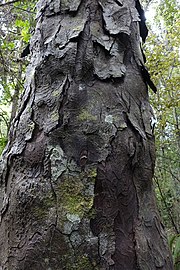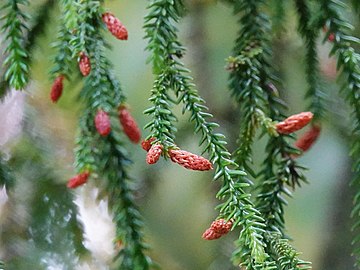Dacrydium cupressinum
| Rimu | |
|---|---|

| |
| A mature rimu | |
| Scientific classification | |
| Kingdom: | Plantae |
| Clade: | Tracheophytes |
| Clade: | Gymnospermae |
| Division: | Pinophyta |
| Class: | Pinopsida |
| Order: | Araucariales |
| Family: | Podocarpaceae |
| Genus: | Dacrydium |
| Species: | D. cupressinum
|
| Binomial name | |
| Dacrydium cupressinum | |

| |
| Natural range ofD. cupressinum | |
| Synonyms[2] | |
|
Thalamia cupressinaSpreng | |
Dacrydium cupressinum,commonly known asrimu,is a large evergreenconiferoustreeendemicto the forests of New Zealand. It is a member of the southernconifergroup, thepodocarps.
TheMāorinamerimucomes from the Polynesian termlimuwhich the tree's foliage were reminded of,[3]ultimately fromProto-Austronesian*limutmeaning "moss".[4]The former name "red pine" has fallen out of common use.
Description
[edit]Rimu is aconiferoustree with dark red wood that reaches a height of 35–60 m (115–197 ft), with a trunk 1.5–2 m (4.9–6.6 ft) in diameter. The bark is flaky and dark-brown in colour. In its juvenile stages the branches are thin and numerous, but as the tree grows older around three quarters of the tree becomes branchless.[5]It has a lifespan of 600–800 years, but may reach beyond 1000 in rare cases.[6]
The yellowish-green foliage varies in size and shape between the juvenile, sub-adult, and adult life stages. The leaves begin 0.4–10 mm long and 0.5–0.1 mm wide with sharp points. They are divided along an axis and roughly shaped like asickle.In sub-adults the leaves shorten to 4–6 mm long, curve upward, and become diamond shaped. In adults the leaves become smaller, just 2–3 mm long, and press against one-another tightly.[5]
Male and female cones, orstrobili,appear first in sub-adults but on differentmale and female trees.Male cones are 5–10 mm long, rectangular shaped, and covered in a yellow pollen.Ovulesappear on their own on upturning branchlets. The fruit consists of a 1–2 mm long fleshy orangereceptacleand a 3–4 mm long dark brown rectangular-shaped seed. Rimu is distinctive enough that it is unlikely to be misidentified except as a seedling withManoao colensoi,which have glossier, less fine leaves. It has adiploidchromosome count of 20.[5]
-
Bark
-
Male cones
-
Fruit
Distribution
[edit]Rimu grows throughout New Zealand, in theNorth Island,South IslandandStewart Island/Rakiura.[2]This species is common in lowland and montane forest.[2]Although the largest concentration of trees is now found on theWest Coastof the South Island, the biggest trees tend to be in mixed podocarp forest nearTaupō(e.g., Pureora, Waihaha, and Whirinaki Forests). A typical North Island habitat is in theHamilton Ecological District,whereFuscospora truncataand rimu form theoverstory.Associate ferns on theforest floorareBlechnum discolor,Blechnum filiforme,Asplenium flaccidumandHymenophyllum demissum.[7]An 800-year-old rimu tree can be seen at theŌtari-Wilton's Bushin Wellington.[8]
Uses
[edit]Māorioriginally used the resinous heartwood of rimu (called māpara or kāpara) for wooden items such as heru (combs) and fernroot beaters.[9][10]Historically, rimu and other native trees such askauri,mataīandtōtarawere the main sources ofwoodfor New Zealand, includingfurnitureandhouseconstruction. However, many of New Zealand's original stands of rimu have been destroyed, and recent government policies forbid the felling of rimu in public forests, though allowing limited logging on private land.Pinus radiatahas now replaced rimu in most industries, although rimu remains popular for the production of high quality wooden furniture. There is also limited recovery of stump and root wood, from trees felled many years before, for use in making bowls and other wood turned objects.[citation needed]
The inner bark can also be used to treat burns and cuts.[11]
In cultivation
[edit]Although slow to establish, with a long juvenile period and fairly high moisture requirements, rimu is widely grown as an ornamental tree in New Zealand. It is attractive at all growth stages, usually quite narrow when young, then developing into a broader tree with weeping branches before finally progressing to its more upright adult form. While rimu does exhibit some variation in the wild, garden cultivars are largely unknown, except for one recent introduction, 'Charisma', which is a compact, golden-foliaged form.[citation needed]
Pests and diseases
[edit]This species plays host to the New Zealand endemic beetleAgapanthida pulchella.[12]
References
[edit]- ^Thomas, P. (2013)."Dacrydium cupressinum".IUCN Red List of Threatened Species.2013:e.T42448A2981038.doi:10.2305/IUCN.UK.2013-1.RLTS.T42448A2981038.en.Retrieved19 November2021.
- ^abcEagle, Audrey (2008).Eagle's complete trees and shrubs of New Zealand volume one.Wellington: Te Papa Press. p. 22.ISBN9780909010089.
- ^"Limu: mosses, seaweed and lichens".Te Māra Reo: The Language Garden.Benton Family Trust. 2022.
- ^Blust, Robert; Trussel, Stephen (2010)."*limut:moss, algae ".Austronesian Comparative Dictionary.Max Planck Institute for Evolutionary Anthropology.Retrieved7 December2022.
- ^abcde Lange, P. J. (2006)."Dacrydium cupressinum".New Zealand Plant Conservation Network.Retrieved16 December2022.
- ^Norton, D. A.; Herbert, J. W.; Beveridge, A. E. (1 January 1988)."The ecology of Dacrydium cupressinum: A review".New Zealand Journal of Botany.26(1): 42.Bibcode:1988NZJB...26...37N.doi:10.1080/0028825X.1988.10410098.ISSN0028-825X.
- ^C. Michael Hogan. 2009.Crown Fern: Blechnum discolor,Globaltwitcher, ed. N. StrombergArchivedFebruary 13, 2012, at theWayback Machine
- ^Wellington City Council."Otari-Wilton's Bush brochure"(PDF).Wellington City Council.Archived(PDF)from the original on 14 February 2014.
- ^Lawrence, Joan (1990)."Combs from Rock Shelters in the Waitakere Ranges, West Auckland".Records of the Auckland Institute and Museum.27:61–71.ISSN0067-0464.JSTOR42906402.WikidataQ58677387.
- ^Wallace, R., & Sutton, D. G. (1989). A preliminary study of wood types used in pre-European Maori wooden artefacts. Saying So Doesn’t Make It So: Papers in Honour of B. Foss Leach. Dunedin: New Zealand Archaeological Association Monograph, 17, 222–232.
- ^"Maori uses: Medicinal plants, Conifers".University of Auckland.Archived fromthe originalon 15 October 2008.Retrieved12 October2008.
- ^Stephanie L. Sopow; John Bain (14 September 2017)."A checklist of New Zealand Cerambycidae (Insecta: Coleoptera), excluding Lamiinae"(PDF).New Zealand Entomologist.40(2): 55–71.doi:10.1080/00779962.2017.1357423.ISSN0077-9962.WikidataQ56166058.
External links
[edit]- "Dacrydium cupressinum".New Zealand Plant Conservation Network.Retrieved3 October2010.




